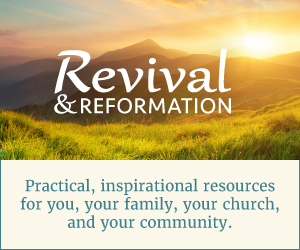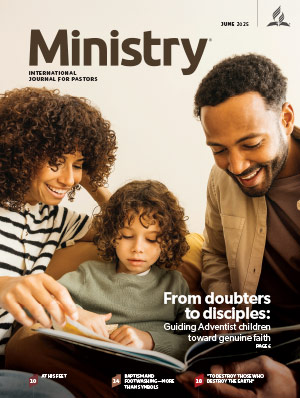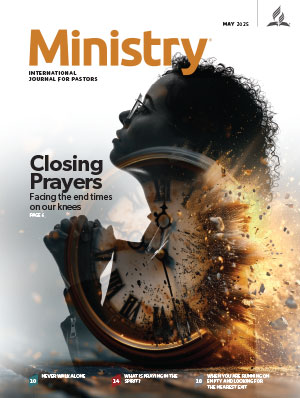Editor’s note: David Klinedinst, MDiv, is the director of evangelism and church growth for the Chesapeake Conference of Seventh-day Adventists. He trains and equips pastors and lay leaders in evangelism and is the speaker for the Forecasting Hope evangelistic series.
Pavel Goia (PG): Many people say public evangelism does not work in our society today, especially in first world countries. Why is public evangelism still important?
David Klinedinst (DK): I’ve been a pastor, evangelist, and departmental director for twenty-seven years and am grateful for all the experiences I’ve had in ministry. I can safely say public evangelism definitely still works when it’s done as part of a full cycle of evangelism. However, if a church just conducts an evangelistic series as an isolated event with little or no preparation of the field, the results will be limited. Like you always say, Pavel, how can we expect to harvest tomatoes if you never planted any tomatoes? When a church has been planting seeds, building relationships, and ministering to people in the community all throughout the year, then public evangelism will work beautifully because the necessary preparation has been done.
PG: What is this cycle of evangelism you are referring to?
DK: Developing an effective twelve-month cycle of evangelism in the local church entails three or four stages. Stage one involves revival. When members experience true spiritual revival and a deeper relationship with Jesus, they naturally want to share their faith with others. I don’t have to coax, guilt, or pressure them. It’s the natural result of revival. “No sooner does one come to Christ than there is born in his heart a desire to make known to others what a precious friend he has found in Jesus; the saving and sanctifying truth cannot be shut up in his heart.”1 So in this stage a church can organize small groups and study materials about revival and reformation. This might be the focus for the first quarter of the year—from January to March.
Stage two involves training and equipping members in ministry skills. I’ve found that there are many members who truly desire to minister and win souls to Jesus. They just need to be shown how to do it. They want practical training and equipping in the principles of soul winning. So in this stage a church can provide training seminars for its members to teach them various ministry skills and the principles of personal evangelism. This might be the focus for the second quarter—from April to June.
Stage three involves conducting bridge events in the community. What’s a bridge event? It’s a ministry meant to meet people’s needs and build relationships with the community. It’s a bridge to connect with people that is not directly spiritual in nature. It could be a health seminar, a depression seminar, a single moms’ group, a basketball or soccer league at the church, a financial health seminar, or even a garden club. You can be as creative as you like. The purpose is to build relationships with people and plant seeds in their hearts. We have to remember—relationships are a big part of soul winning. These bridge events might be your focus in the third quarter—from July to September.
Stage four is reaping. This is where you harvest the seeds that you’ve planted and invite people to follow Christ by conducting a reaping series or evangelistic meeting. You’ve built the relationships and gained trust. Now you’re giving them an opportunity to choose Jesus. Your evangelistic meeting may look different depending on your context. It might be two weeks, three weeks, four weeks. The point is you have to ask people to make a decision for Christ. In the first three stages of the cycle, you have gained trust and connected with their heart. Now, in stage four, you are sharing spiritual truths with them and inviting them to act. The reaping might be your focus in the fourth quarter—from October to December.
Churches that develop a cycle of evangelism will eventually become multiplying churches that are successfully making disciples for Jesus.
PG: I see in your evangelism cycle that friendship and relationships are a big part of soul winning. Why is it so essential?
DK: Trust is not negotiable. You will never win someone to Jesus who doesn’t trust you first. I can’t just throw doctrinal information at them from a distance. I have to engage with them, connect with their heart, and interact with them. That’s what Jesus did. He didn’t just preach in the synagogue. He had a very personal ministry. There is a big difference between someone who is simply a lecturer throwing out truth from a distance and someone who seeks to reach the heart, not just give information.
PG: How do you bolster the spiritual health of a church and prepare them to welcome and love the new attendees and seekers?
DK: One of the best ways is what you speak about all the time, Pavel—develop a prayer ministry where the church gathers together to pray for family, friends, neighbors, and other interests—in an intentional and organized way. When you pray for people, you become invested in their lives and intensely interested in their salvation. The natural result is that when a member is personally involved in ministering to others, they then care a lot more about their church being a safe place. Another way is to get attendees and new believers involved in mission and outreach right away. When you get people involved in service, they become much more interested in making sure their church is a loving community that will help people in their spiritual journey.
PG: What kind of follow-up should be done to retain new believers and seekers?
DK: When I conduct an evangelistic series, I insist that the church have a follow-up class that meets at least once a week after the evangelistic series is over. The class enables you to continue to build solid relationships with guests and provides a way to disciple them. Many of the guests who didn’t make a decision during the evangelistic meetings will make decisions during the follow-up class and beyond. But the class needs to be on the same theme as the evangelistic meetings. For example, if the theme of the evangelistic meetings was Bible prophecy, then your class should be on the same theme. That theme attracted them in the first place. Why would you change it?
Another important way to retain people is to get them involved in the ministry of the church—even if they are not members yet. Give them something to do—even if it’s as simple as being a greeter at the door or handing out Sabbath School quarterlies. People who are involved and given a job usually stay connected. It is when a person is isolated and alone that they fall away. This is the key to retention.
PG: Are there any resources that will help a church conduct an effective evangelistic series?
DK: Yes, there are a few. We recently partnered with SermonView and Advent Source to create a brand-new evangelism kit called Forecasting Hope, which equips pastors and lay leaders with everything they need to plan and conduct a powerful evangelistic series.2 It Is Written, the Voice of Prophecy, and ASI [Adventist-laymen's Services and Industries] have also developed evangelism kits to provide necessary resources to churches.
PG: You have done a vast amount of evangelism training throughout North America. What kind of seminars and teaching resources do you provide?
DK: We provide training on the principles of soul winning and how to create the culture of evangelism in the local church, develop a cycle of evangelism, make personal and public appeals, reach the heart, preach Christ in the doctrines, help people make spiritual decisions, get decisions and recognize conviction, and visit people, just to name a few.
My greatest passion, though, is to equip pastors and leaders on how to present the topics of an evangelistic series in a Christ-centered, positive, and relational way.3
We also help conferences provide in-person training to pastors and lay leaders through something called Proclaim Evangelism cohorts. These are twelve-month cohorts that meet four times a year (once a quarter) to disciple pastors and lay leaders in effective evangelistic methods. A cohort usually consists of twelve to twenty people, and each of the four modules focuses on a specific aspect of effective evangelism. We can help a conference start these cohorts in their territory.4
When you equip people with powerful evangelistic skills, it creates a mission-driven, lay-led church reaching people for Christ. It multiplies soul winners. Jesus said, “The harvest truly is great, but the laborers are few” [Luke 10:2, KJV]. We want to equip and disciple more laborers!
PG: Do you have any final words for pastors wanting to conduct fruitful evangelism?
DK: Let me conclude with an inspiring story of what God can do in a local church committed to fostering a culture of evangelism and developing a cycle of evangelism.
A few years ago I was asked to conduct a series of evangelistic meetings in a small town just outside a large urban area. It was a smaller church that struggled to survive in past years. But the church had a new vision led by a lay pastor. This lay pastor worked forty hours a week at another job. But he and the leaders worked diligently to develop a full cycle of evangelism that included building relationships in the community, conducting bridge events regularly, meeting people’s needs, and giving people Bible studies. When I came to conduct the evangelistic meetings, they already had many interests from the community who came to the meetings and made decisions. Because the church had already been working with them, all I had to do was simply call them to make a decision. This average-sized Seventh-day Adventist church of thirty to forty members became the fastest-growing church in the conference. That can happen in any church!
In every city there are people whose hearts are open to truth. In every town or village, there are people who are searching for something better. God wants to connect them with your church. God calls us to reach them. There is no other option—Jesus is coming soon! Every church must be mission-driven, and every member a soul winner.
- Ellen G. White, Steps to Christ (Mountain View, CA: Pacific Press, 1892), 87.
- For more information about Forecasting Hope, visit the SermonView website at https://www.evangelismmarketing.com/forecastinghope.
- For a list of David’s evangelism training topics and resources, visit the Proclaim Evangelism Models page on the Chesapeake Conference of Seventh-day Adventists website at https://www.ccosda.org/david.
- See the Proclaim Evangelism Modules page on the Chesapeake Conference website at https://www.ccosda.org/proclaim.













